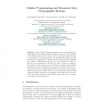928 search results - page 182 / 186 » Evolutionary algorithms and matroid optimization problems |
GECCO
2007
Springer
14 years 1 months ago
2007
Springer
The topological properties of a network directly impact the flow of information through a system. For example, in natural populations, the network of inter-individual contacts aff...
GECCO
2005
Springer
14 years 1 months ago
2005
Springer
Resource-Limited Genetic Programming is a bloat control technique that imposes a single limit on the total amount of resources available to the entire population, where resources ...
GECCO
2004
Springer
14 years 1 months ago
2004
Springer
In evolutionary algorithms a common method for encoding neural networks is to use a tree-structured assembly procedure for constructing them. Since node operators have difficulties...
GECCO
2003
Springer
14 years 27 days ago
2003
Springer
Abstract. The problem of designing symmetric key cryptography algorithms based upon cellular automata (CAs) is considered. The reliability of the Vernam cipher used in the process ...
GCB
2000
Springer
13 years 11 months ago
2000
Springer
Conventional phylogenetic tree estimation methods assume that all sites in a DNA multiple alignment have the same evolutionary history. This assumption is violated in data sets fro...

